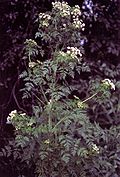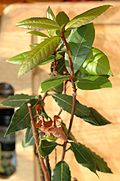Difference between revisions of "AY Honors/Goat Husbandry/Answer Key"
Jomegat bot (talk | contribs) (Bot: Automated import of articles *** existing text overwritten ***) |
m |
||
| Line 4: | Line 4: | ||
<noinclude><translate><!--T:44--> | <noinclude><translate><!--T:44--> | ||
</noinclude> | </noinclude> | ||
| − | <!-- 1. Identify live or from pictures at least two breeds of goats. Tell if they are raised for milk, meat, or wool. | + | <!-- 1. Identify live or from pictures at least two breeds of goats. Tell if they are raised for milk, meat, or wool. --> |
<!--T:3--> | <!--T:3--> | ||
| Line 27: | Line 27: | ||
<noinclude><translate><!--T:46--> | <noinclude><translate><!--T:46--> | ||
</noinclude> | </noinclude> | ||
| − | <!-- 2. What type of housing should be provided for goats? | + | <!-- 2. What type of housing should be provided for goats? --> |
| − | Goats are very adaptable animals, so many types of housing will suit them. | + | Goats are very adaptable animals, so many types of housing will suit them. A three-sided shed will work just fine in most cases, and the goats will seek it out when it rains or snows. The only time they need better housing is when they are kidding, in which case they need a draft-free area. Several goats can kid together in an indoor pen (in a barn or other building). Up to ten does can share a 20 square foot pen (4'x5'). |
<!--T:9--> | <!--T:9--> | ||
| − | The floor should be dirt or stone - concrete is not recommended. | + | The floor should be dirt or stone - concrete is not recommended. The floor should have 3-4 inches of bedding covering it (5"-6" if concrete). Bedding can be straw, sawdust, wood chips, newspaper, or some other absorbent material. |
<!--T:47--> | <!--T:47--> | ||
| Line 44: | Line 44: | ||
<noinclude><translate><!--T:49--> | <noinclude><translate><!--T:49--> | ||
</noinclude> | </noinclude> | ||
| − | Kids should drink their mother's milk within 20 minutes of birth. | + | Kids should drink their mother's milk within 20 minutes of birth. At this stage it will contain colostrum which is not much good for people to drink. Most goat keepers will allow a newborn kid to have all its mothers milk for the first couple of weeks until the colostrum is gone. |
<!--T:11--> | <!--T:11--> | ||
| Line 50: | Line 50: | ||
<!--T:50--> | <!--T:50--> | ||
| − | You can also make hay available to them right from the start. | + | You can also make hay available to them right from the start. They may not eat it at this stage, but it's a good idea to let them get used to it. |
<noinclude></translate></noinclude> | <noinclude></translate></noinclude> | ||
{{CloseReq}} <!-- 3a --> | {{CloseReq}} <!-- 3a --> | ||
| Line 56: | Line 56: | ||
<noinclude><translate><!--T:51--> | <noinclude><translate><!--T:51--> | ||
</noinclude> | </noinclude> | ||
| − | Some goat keepers will separate the kids from their mothers at night. | + | Some goat keepers will separate the kids from their mothers at night. As long as all the kids are kept together, they will be happy, and the mothers seem to enjoy the break. This will allow you to milk the mothers in the evening. |
<!--T:13--> | <!--T:13--> | ||
| − | Kids should be fed grain, minerals, hay, and a yeast culture made for this purpose. | + | Kids should be fed grain, minerals, hay, and a yeast culture made for this purpose. The yeast culture will help to establish the right kind of bacteria in the goat's rumen. Kids need a mineral with copper in it (most minerals that say they are for sheep and goats will not contain copper - avoid this). |
<!--T:52--> | <!--T:52--> | ||
| Line 68: | Line 68: | ||
<noinclude><translate><!--T:53--> | <noinclude><translate><!--T:53--> | ||
</noinclude> | </noinclude> | ||
| − | Feed pregnant does about a pound of grain each day. | + | Feed pregnant does about a pound of grain each day. They should also have hay twice a day in winter and once a day in summer. Allow them to browse in the pasture and give them minerals as well. |
<noinclude></translate></noinclude> | <noinclude></translate></noinclude> | ||
{{CloseReq}} <!-- 3c --> | {{CloseReq}} <!-- 3c --> | ||
| Line 74: | Line 74: | ||
<noinclude><translate><!--T:54--> | <noinclude><translate><!--T:54--> | ||
</noinclude> | </noinclude> | ||
| − | A "freshened" doe is one that has just given birth and is just beginning to produce milk. | + | A "freshened" doe is one that has just given birth and is just beginning to produce milk. She should be given 2-3 pound of grain per day, as well as some hay twice per day. She should also be given minerals, a yeast supplement, and be allowed to browse in the pasture. |
<!--T:55--> | <!--T:55--> | ||
| Line 82: | Line 82: | ||
<noinclude><translate><!--T:56--> | <noinclude><translate><!--T:56--> | ||
</noinclude> | </noinclude> | ||
| − | Yearlings should be given one cup of grain per day, hay twice per day in winter or once per day in summer. | + | Yearlings should be given one cup of grain per day, hay twice per day in winter or once per day in summer. They should also be given a mineral supplement, a yeast supplement, and be allowed to browse in the pasture. |
<!--T:57--> | <!--T:57--> | ||
| Line 108: | Line 108: | ||
<noinclude><translate><!--T:60--> | <noinclude><translate><!--T:60--> | ||
</noinclude> | </noinclude> | ||
| − | <!-- 5. When are kids weaned? | + | <!-- 5. When are kids weaned? --> |
Kids are weaned at 6 to 8 weeks of age. | Kids are weaned at 6 to 8 weeks of age. | ||
| Line 117: | Line 117: | ||
<noinclude><translate><!--T:62--> | <noinclude><translate><!--T:62--> | ||
</noinclude> | </noinclude> | ||
| − | <!-- 6. When must the buck kids be removed from the does, and why? | + | <!-- 6. When must the buck kids be removed from the does, and why? --> |
| − | Separate young bucks from the does when they become two months old. | + | Separate young bucks from the does when they become two months old. Bucks reach puberty between 7 weeks and 8 months, and if they are with the does when this happens, they will attempt to mate with them. They need to be separated before puberty so this does not happen. |
<!--T:63--> | <!--T:63--> | ||
| Line 126: | Line 126: | ||
<noinclude><translate><!--T:64--> | <noinclude><translate><!--T:64--> | ||
</noinclude> | </noinclude> | ||
| − | <!-- 7. How are goat's hoofs trimmed? | + | <!-- 7. How are goat's hoofs trimmed? --> |
See http://www.boergoatshome.com/hooves.php for a very good tutorial on trimming goat hooves. | See http://www.boergoatshome.com/hooves.php for a very good tutorial on trimming goat hooves. | ||
<!--T:20--> | <!--T:20--> | ||
| − | Goat hooves are trimmed with a specialized tool designed for the job and called (unsurprisingly) ''hoof shears''. | + | Goat hooves are trimmed with a specialized tool designed for the job and called (unsurprisingly) ''hoof shears''. The first step is to clean the hoof thoroughly. When the hooves are clean enough, you should be able to see growth lines in them. The hooves should be trimmed parallel to these lines. The hoof should be trimmed short enough so that the front slopes straight down without curling at the tip. Once they are trimmed, you should use a surform to shape and smooth it. A surform is a carpenters tool that looks like a cross between a handplane and a cheese grater. |
<!--T:21--> | <!--T:21--> | ||
| − | If you have large rocks in your pasture, you will need to trim their hooves less frequently. | + | If you have large rocks in your pasture, you will need to trim their hooves less frequently. The goats will climb on the rocks and wear their hooves down naturally. |
<!--T:65--> | <!--T:65--> | ||
| Line 141: | Line 141: | ||
<noinclude><translate><!--T:66--> | <noinclude><translate><!--T:66--> | ||
</noinclude> | </noinclude> | ||
| − | <!-- 8. Why are goats good for clearing brush land? | + | <!-- 8. Why are goats good for clearing brush land? --> |
| − | Goats are reputed to be willing to eat almost anything. The digestive systems of a goat allow nearly any organic substance to be broken down and used as nutrients. | + | Goats are reputed to be willing to eat almost anything. The digestive systems of a goat allow nearly any organic substance to be broken down and used as nutrients. Contrary to this reputation, they are quite fastidious in their habits, preferring to browse on the tips of woody shrubs and trees, as well as the occasional broad leaved plant. However, it can fairly be said that goats will eat almost anything in the botanical world. Their plant diet is extremely varied and includes some species which are toxic or detrimental to cattle and sheep. This makes them valuable for controlling weeds and clearing brush and undergrowth. |
<!--T:67--> | <!--T:67--> | ||
| Line 165: | Line 165: | ||
<noinclude><translate><!--T:70--> | <noinclude><translate><!--T:70--> | ||
</noinclude> | </noinclude> | ||
| − | <!-- 10. What are wattles? | + | <!-- 10. What are wattles? --> |
A wattle is a fleshy dewlap hanging from a goat's neck. | A wattle is a fleshy dewlap hanging from a goat's neck. | ||
| Line 174: | Line 174: | ||
<noinclude><translate><!--T:72--> | <noinclude><translate><!--T:72--> | ||
</noinclude> | </noinclude> | ||
| − | <!-- 11. Raise at least two goats for six months. | + | <!-- 11. Raise at least two goats for six months. --> |
Have fun! | Have fun! | ||
| Line 181: | Line 181: | ||
<!--T:27--> | <!--T:27--> | ||
| − | Goats are herd animals, so you should get more than one. | + | Goats are herd animals, so you should get more than one. If you have only one goat, it will not be happy and will continually cry for your attention. If you are a novice, you absolutely do not want a buck. If you only want one doe, the second animal should be a wether (castrated male). A wether should cost less than half what a doe costs, and will be more friendly than either a buck or a doe. You could also get a second doe instead of a wether if you think you can keep up with milking them. |
<!--T:73--> | <!--T:73--> | ||
| Line 194: | Line 194: | ||
<noinclude><translate><!--T:75--> | <noinclude><translate><!--T:75--> | ||
</noinclude> | </noinclude> | ||
| − | A milking goat needs to have a good udder. | + | A milking goat needs to have a good udder. It should be held tightly against her body and not sag. If she has not yet developed an udder, check her mother, and make sure her father produces goats with good udders. The teats should be well formed. |
<!--T:29--> | <!--T:29--> | ||
| − | Get a gentle doe, as an aggressive one will be difficult to milk. | + | Get a gentle doe, as an aggressive one will be difficult to milk. She should not run away from you when you approach her, and she should allow you to touch her. If she does not allow you to touch her, don't buy her. Once she becomes skittish of people, it is nearly impossible to "tame" her again. |
<!--T:30--> | <!--T:30--> | ||
| − | Choose goats that have good "conformation" - meaning they have all the right proportions for their breed. | + | Choose goats that have good "conformation" - meaning they have all the right proportions for their breed. Also make sure the goat you choose is healthy and strong. |
<!--T:31--> | <!--T:31--> | ||
| − | Does should look feminine rather than masculine. | + | Does should look feminine rather than masculine. In general, a more feminine-looking goat will produce more milk than a masculine one will. |
<!--T:76--> | <!--T:76--> | ||
| Line 217: | Line 217: | ||
<!--T:34--> | <!--T:34--> | ||
| − | Pasteurization typically uses temperatures below boiling since at temperatures above the boiling point for milk, casein micelles will irreversibly aggregate (or "curdle"). There are two main types of pasteurization used today: High Temperature/Short Time (HTST) and Extended Shelf Life (ESL) treatment. | + | Pasteurization typically uses temperatures below boiling since at temperatures above the boiling point for milk, casein micelles will irreversibly aggregate (or "curdle"). There are two main types of pasteurization used today: High Temperature/Short Time (HTST) and Extended Shelf Life (ESL) treatment. In the HTST process, milk is forced between metal plates or through pipes heated on the outside by hot water, and is heated to 71.7 °C (161 °F) for 15-20 seconds. ESL milk has a microbial filtration step and lower temperatures than HTST. Milk simply labeled "pasteurized" is usually treated with the HTST method. |
<!--T:78--> | <!--T:78--> | ||
| Line 231: | Line 231: | ||
<noinclude><translate><!--T:80--> | <noinclude><translate><!--T:80--> | ||
</noinclude> | </noinclude> | ||
| − | Before you do any milking, you will need to sterilize your equipment. | + | Before you do any milking, you will need to sterilize your equipment. Failure to do so will yield foul-tasting or contaminated milk, and neither of these is desirable. Sterilization can be accomplished by soaking the equipment in bleach water (¼ cup bleach for every two gallons or water, or 1 part bleach to every 128 parts water) for a minimum of two minutes. Then drain out the bleach water and allow the water and bleach to evaporate for at least 15 minutes. |
<!--T:36--> | <!--T:36--> | ||
| − | Before you begin milking, you should clean the doe's udder. | + | Before you begin milking, you should clean the doe's udder. Again, you can use bleach water for this. Wash the area thoroughly, as this will help you prevent the spread of mastitis (an udder infection). Dry her off with a disposable paper towel. Use a seamless, stainless steel pail to catch the milk. Make sure you use a seamless pail, because the seams are nearly impossible to get clean. Some people like to use a goat-hobble to keep the doe from stepping into the pail during milking (if this happens, everything in the pail is ruined, and you will have to re-sterilize the pail before you can reuse it). |
<!--T:37--> | <!--T:37--> | ||
| − | Now for the milking part. | + | Now for the milking part. Do not pull on the goat's teats, as this can injure her. Instead, grip the teat (not the udder!) and squeeze your index finger closed, followed by the middle finger, ring finger, and pinky. This will progressively constrict the teat and force the milk out the orifice. It may take a while to get the hang of this, but be patient and persistent. Your goat will be able to read your frustration level, so patience is important. Once you get the hang of it, the milking motion will become second nature. |
<!--T:38--> | <!--T:38--> | ||
| − | Express three to four squirts into the pail and then check for abnormalities (such as blood clots). | + | Express three to four squirts into the pail and then check for abnormalities (such as blood clots). Then continue milking until she milks out. When finished, cover the pail. Then pour a solution of bleach water (2 Tbsp bleach, 1 quart water) into a small paper cup and dip the doe's teats in this solution. |
<!--T:39--> | <!--T:39--> | ||
| − | At this point you should weigh the milk and record your reading. | + | At this point you should weigh the milk and record your reading. Then transfer the milk to a milk tote (also seamless and stainless steel), and move on to the next goat, or get the milk into a refrigerator or into a pasteurizer. |
<!--T:81--> | <!--T:81--> | ||
| Line 251: | Line 251: | ||
<noinclude><translate><!--T:82--> | <noinclude><translate><!--T:82--> | ||
</noinclude> | </noinclude> | ||
| − | You can create a chart such as this, filling in the amount of milk each doe produces on each day. | + | You can create a chart such as this, filling in the amount of milk each doe produces on each day. Standard practice is to record the milk's weight rather than its volume. Record the doe's name (or some other identifier) at the top of the columns between the "Date" and "Notes" fields. Record general health information or any unusual observations in the Notes column. You can also use a spreadsheet to track this information. |
<!--T:41--> | <!--T:41--> | ||
Revision as of 21:15, 2 April 2021
1
Adventist Youth Honors Answer Book/Goat Breeds/Saanen
Adventist Youth Honors Answer Book/Goat Breeds/Toggenburg
Adventist Youth Honors Answer Book/Goat Breeds/Nubian
Adventist Youth Honors Answer Book/Goat Breeds/British Alpine
You may also visit http://www.ansi.okstate.edu/breeds/goats/ for pictures and information on different goat breeds.
2
Goats are very adaptable animals, so many types of housing will suit them. A three-sided shed will work just fine in most cases, and the goats will seek it out when it rains or snows. The only time they need better housing is when they are kidding, in which case they need a draft-free area. Several goats can kid together in an indoor pen (in a barn or other building). Up to ten does can share a 20 square foot pen (4'x5').
The floor should be dirt or stone - concrete is not recommended. The floor should have 3-4 inches of bedding covering it (5"-6" if concrete). Bedding can be straw, sawdust, wood chips, newspaper, or some other absorbent material.
3
3a
Kids should drink their mother's milk within 20 minutes of birth. At this stage it will contain colostrum which is not much good for people to drink. Most goat keepers will allow a newborn kid to have all its mothers milk for the first couple of weeks until the colostrum is gone.
They will also get milk from their mothers, and this should be available to them at all times.
You can also make hay available to them right from the start. They may not eat it at this stage, but it's a good idea to let them get used to it.
3b
Some goat keepers will separate the kids from their mothers at night. As long as all the kids are kept together, they will be happy, and the mothers seem to enjoy the break. This will allow you to milk the mothers in the evening.
Kids should be fed grain, minerals, hay, and a yeast culture made for this purpose. The yeast culture will help to establish the right kind of bacteria in the goat's rumen. Kids need a mineral with copper in it (most minerals that say they are for sheep and goats will not contain copper - avoid this).
You should also turn them out to pasture during the day to let them browse.
3c
Feed pregnant does about a pound of grain each day. They should also have hay twice a day in winter and once a day in summer. Allow them to browse in the pasture and give them minerals as well.
3d
A "freshened" doe is one that has just given birth and is just beginning to produce milk. She should be given 2-3 pound of grain per day, as well as some hay twice per day. She should also be given minerals, a yeast supplement, and be allowed to browse in the pasture.
3e
Yearlings should be given one cup of grain per day, hay twice per day in winter or once per day in summer. They should also be given a mineral supplement, a yeast supplement, and be allowed to browse in the pasture.
4
5
Kids are weaned at 6 to 8 weeks of age.
6
Separate young bucks from the does when they become two months old. Bucks reach puberty between 7 weeks and 8 months, and if they are with the does when this happens, they will attempt to mate with them. They need to be separated before puberty so this does not happen.
7
See http://www.boergoatshome.com/hooves.php for a very good tutorial on trimming goat hooves.
Goat hooves are trimmed with a specialized tool designed for the job and called (unsurprisingly) hoof shears. The first step is to clean the hoof thoroughly. When the hooves are clean enough, you should be able to see growth lines in them. The hooves should be trimmed parallel to these lines. The hoof should be trimmed short enough so that the front slopes straight down without curling at the tip. Once they are trimmed, you should use a surform to shape and smooth it. A surform is a carpenters tool that looks like a cross between a handplane and a cheese grater.
If you have large rocks in your pasture, you will need to trim their hooves less frequently. The goats will climb on the rocks and wear their hooves down naturally.
8
Goats are reputed to be willing to eat almost anything. The digestive systems of a goat allow nearly any organic substance to be broken down and used as nutrients. Contrary to this reputation, they are quite fastidious in their habits, preferring to browse on the tips of woody shrubs and trees, as well as the occasional broad leaved plant. However, it can fairly be said that goats will eat almost anything in the botanical world. Their plant diet is extremely varied and includes some species which are toxic or detrimental to cattle and sheep. This makes them valuable for controlling weeds and clearing brush and undergrowth.
9
- Gloves
- Drumheads
- Rugs
- Boots
- Wineskin (Bible times in particular)
- Lampshades
- Coats
10
A wattle is a fleshy dewlap hanging from a goat's neck.
11
Have fun!
You can usually find information on goat care on the computer or at your library.
Goats are herd animals, so you should get more than one. If you have only one goat, it will not be happy and will continually cry for your attention. If you are a novice, you absolutely do not want a buck. If you only want one doe, the second animal should be a wether (castrated male). A wether should cost less than half what a doe costs, and will be more friendly than either a buck or a doe. You could also get a second doe instead of a wether if you think you can keep up with milking them.
12
12a
A milking goat needs to have a good udder. It should be held tightly against her body and not sag. If she has not yet developed an udder, check her mother, and make sure her father produces goats with good udders. The teats should be well formed.
Get a gentle doe, as an aggressive one will be difficult to milk. She should not run away from you when you approach her, and she should allow you to touch her. If she does not allow you to touch her, don't buy her. Once she becomes skittish of people, it is nearly impossible to "tame" her again.
Choose goats that have good "conformation" - meaning they have all the right proportions for their breed. Also make sure the goat you choose is healthy and strong.
Does should look feminine rather than masculine. In general, a more feminine-looking goat will produce more milk than a masculine one will.
12b
Pasteurization is the process of heating liquids for the purpose of destroying viruses and harmful organisms such as bacteria, protozoa, molds, and yeasts.
Unlike sterilization, pasteurization is not intended to kill all micro-organisms in the food or liquid. Instead, pasteurization aims to achieve a "logarithmic reduction" in the number of viable organisms, reducing their number so they are unlikely to cause disease (assuming the pasteurized product is refrigerated and consumed before its expiration date). Commercial-scale sterilization of food is not common, because it adversely affects the taste and quality of the product.
Pasteurization typically uses temperatures below boiling since at temperatures above the boiling point for milk, casein micelles will irreversibly aggregate (or "curdle"). There are two main types of pasteurization used today: High Temperature/Short Time (HTST) and Extended Shelf Life (ESL) treatment. In the HTST process, milk is forced between metal plates or through pipes heated on the outside by hot water, and is heated to 71.7 °C (161 °F) for 15-20 seconds. ESL milk has a microbial filtration step and lower temperatures than HTST. Milk simply labeled "pasteurized" is usually treated with the HTST method.
13
13a
Before you do any milking, you will need to sterilize your equipment. Failure to do so will yield foul-tasting or contaminated milk, and neither of these is desirable. Sterilization can be accomplished by soaking the equipment in bleach water (¼ cup bleach for every two gallons or water, or 1 part bleach to every 128 parts water) for a minimum of two minutes. Then drain out the bleach water and allow the water and bleach to evaporate for at least 15 minutes.
Before you begin milking, you should clean the doe's udder. Again, you can use bleach water for this. Wash the area thoroughly, as this will help you prevent the spread of mastitis (an udder infection). Dry her off with a disposable paper towel. Use a seamless, stainless steel pail to catch the milk. Make sure you use a seamless pail, because the seams are nearly impossible to get clean. Some people like to use a goat-hobble to keep the doe from stepping into the pail during milking (if this happens, everything in the pail is ruined, and you will have to re-sterilize the pail before you can reuse it).
Now for the milking part. Do not pull on the goat's teats, as this can injure her. Instead, grip the teat (not the udder!) and squeeze your index finger closed, followed by the middle finger, ring finger, and pinky. This will progressively constrict the teat and force the milk out the orifice. It may take a while to get the hang of this, but be patient and persistent. Your goat will be able to read your frustration level, so patience is important. Once you get the hang of it, the milking motion will become second nature.
Express three to four squirts into the pail and then check for abnormalities (such as blood clots). Then continue milking until she milks out. When finished, cover the pail. Then pour a solution of bleach water (2 Tbsp bleach, 1 quart water) into a small paper cup and dip the doe's teats in this solution.
At this point you should weigh the milk and record your reading. Then transfer the milk to a milk tote (also seamless and stainless steel), and move on to the next goat, or get the milk into a refrigerator or into a pasteurizer.
13b
You can create a chart such as this, filling in the amount of milk each doe produces on each day. Standard practice is to record the milk's weight rather than its volume. Record the doe's name (or some other identifier) at the top of the columns between the "Date" and "Notes" fields. Record general health information or any unusual observations in the Notes column. You can also use a spreadsheet to track this information.
| Date | Notes | ||||
|---|---|---|---|---|---|
| Sun | |||||
| Mon | |||||
| Tue | |||||
| Wed | |||||
| Thu | |||||
| Fri | |||||
| Sat | |||||









